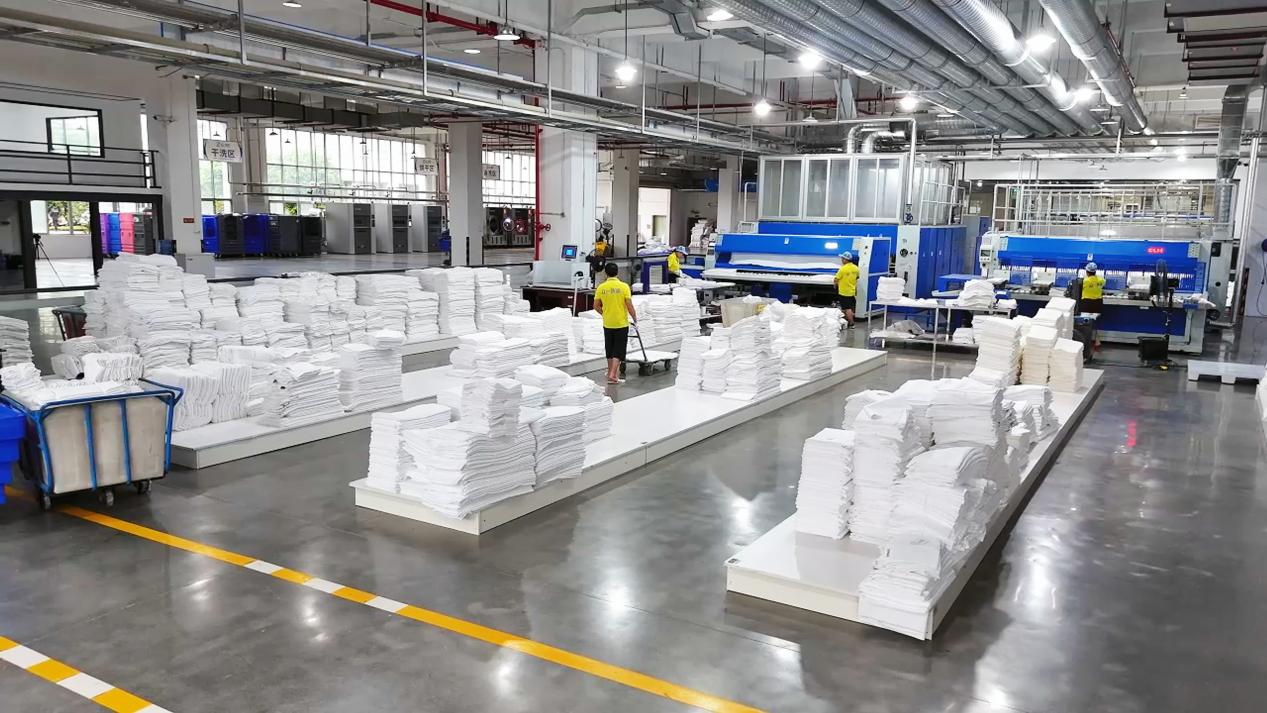In fields such as hotels, restaurants, hospitals, and railways, the usage of pure cotton white fabrics (bed sheets, towels, tablecloths, napkins…) is huge. The washing quality of such linen is directly related to service quality and operating costs. As a core link to remove oxidizing dirt and restore the whiteness of the textiles, chlorine bleach not only plays a decisive role in the washing effect but is also closely related to the service life of the textiles. In the process of chlorine, if the operation is inappropriate, it may cause damage to the fibers of the textiles. After multiple rinses, there may be problems like lower fastness and damage. They are the important factors that have an impact on the service life of the linen laundry plants.
Precisely Control the Rinsing Time and Avoid Invalid Operations
In the process of rinsing, the setting of bleaching time should match the release pattern of the bleach. Industry data shows that under ideal bleaching temperature and a pH value of 10.5, bleach dissolves evenly in the washing solution 1 minute after being added, and available chlorine starts to release uniformly thereafter. The chlorine is basically fully released after 6-8 minutes, with the available chlorine concentration in the solution being approximately 10ppm at this point.
Since the available chlorine content is required to be below 10ppm during drainage, extending the bleaching time after the complete release of available chlorine will not improve the bleaching effect. Instead, it may increase the risk of damage. Therefore, laundry plants must set the bleaching duration accurately based on this pattern to avoid resource waste and fabric loss caused by ineffective operations.
Scientific Bleaching Temperature and Appropriate Bleaching Agents
When setting the bleaching programs, people should choose bleach (chlorine bleach or oxygen bleach) according to the characteristics of the textiles and colors.
● Chlorine bleach
Temperature control is important. Increasing the temperature of the bleaching solution can accelerate the bleaching speed and shorten the duration. Generally, for every 10℃ increase in temperature, the bleaching time can be shortened by half. However, the chlorine bleaching temperature should be controlled to ≤ 65℃. Otherwise, it will cause the yellowing of the textiles and a decrease in fastness.
● Oxygen bleach
It will be best if the temperature is between 70℃ and 90℃ because it can not only ensure the bleaching effects but also reduce the bad impacts on textiles.
Reasonably Determine Bleach Bath Concentration to Balance Effect and Cost
The selection of bleach bath concentration should both provide a good bleaching effect, but also protect the textiles to avoid resource waste and fiber damage caused by an extremely high concentration. The practice shows that improving the dosage of chlorine bleach within a range can improve the bleaching effects. However, once the limit is reached, even if the concentration is increased, there will be no big change in the effect.
● For different soil levels, the chlorine content in the bleach bath is recommended to be controlled as follows.
50mg/L for light soil (50ppm available chlorine)
75mg/L for moderate soil (75ppm available chlorine)
100-120mg/L for heavy soil (over 100ppm available chlorine)
It is very important that the available chlorine concentration above 120ppm will significantly shorten fabric service life.
Optimize pH Value of the Bleach Solution to Reduce Fiber Damage
The pH value of the bleach solution has a significant impact on fabric fastness. In different pH conditions, there are differences in bleaching effect and fiber damage.
● When the pH value is neutral (7), fabric damage is relatively severe.
● Under acidic conditions, the bleaching speed is fast, but fiber damage is serious. (not recommended normally)
● Industry practice has shown that the optimal pH range for chlorine bleaching is 10.2-10.5. Under this condition, the bleaching speed is moderate and fiber damage is minimized.
To optimize the process, some laundry plants let the main washing and rinsing be done at the same time. This not only stably maintains the optimal pH value but also ensures bleaching effectiveness.
Conclusion
For linen laundry plants, making a scientific and reasonable chlorine bleaching process, strictly controlling key parameters (temperature, time, concentration, pH value…) can improve washing quality and effectively extend the service life of textiles. It can reduce costs for customers and improve their market competitiveness. In the future, with the development of the laundry industry’s requirements for green laundry, high efficiency, and energy saving, the refined control of chlorine bleaching will become an important direction for linen laundry enterprises to achieve high-quality development.
Post time: Oct-17-2025


